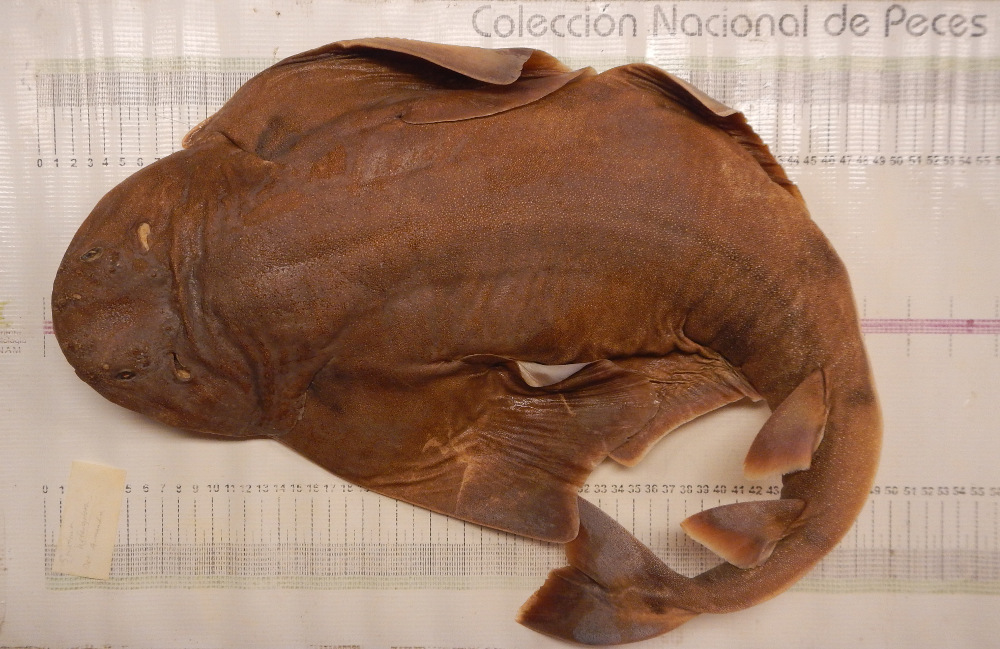Squatina mexicana
Castro-Aguirre, Espinosa Pérez & Huidobro Campos, 2007
Classification: Elasmobranchii Squatiniformes Squatinidae
Reference of the original description
Dos nuevas especies del género Squatina (Chondrichthyes: Squatinidae) del Golfo de México. Revista de Biología Tropical, 54(3): 1031–1040
Dos nuevas especies del género Squatina (Chondrichthyes: Squatinidae) del Golfo de México. Revista de Biología Tropical, 54(3): 1031–1040
Image of the original description
Image in copyright.
Image in copyright.
Types
Squatina mexicana
Holotype: IBUNAM: P 8306; Paratype: IBUNAM: P 12723; IBUNAM: P 12724; IBUNAM: P 11136;
Squatina mexicana
Holotype: IBUNAM: P 8306; Paratype: IBUNAM: P 12723; IBUNAM: P 12724; IBUNAM: P 11136;
Description :
Citation: Squatina mexicana Castro-Aguirre, Espinosa Pérez & Huidobro Campos, 2007: In: Database of modern sharks, rays and chimaeras, www.shark-references.com, World Wide Web electronic publication, Version 12/2025
Please send your images of "Squatina mexicana" to info@shark-references.com

Squatina mexicana Castro-Aguirre, Espinosa Pérez & Huidobro Campos,2007; female, paratype, (collection nr.: CNPEIBUNAM- 11136) © Hector S. Espinosa Pérez, Colección Nacional de Peces Instituto de Biología, Unam Ciudad Universitaria, México

Squatina mexicana Castro-Aguirre, Espinosa Pérez & Huidobro Campos,2007; female, paratype, (collection nr.: CNPEIBUNAM- 11136) © Hector S. Espinosa Pérez, Colección Nacional de Peces Instituto de Biología, Unam Ciudad Universitaria, México
Short Description
This species has no thorns or enlarged denticles on the mean dorsal line. The dermal skin denticles has 3 keels extended posteriorly, its base about 4 times its length. The dorsal fins are similar in size, shape and area, their base about 1.75 times their height. Nasal lobes are simple, the anterior thin and longer; the medium lobe quadrangular and almost lacking lobes Body color gray, no ocelli, but with 2 very evident black spots on the anterior edge of pectoral fins; the rest of body is black with small scattered dark spots located irregularly. Both sides of the upper jaw has 10 triangular, erect, and non edge-serrated teeth, arranged in 2 functional series; lower jaw with 9-10 smooth triangular teeth; 5 frontal teeth are straight, the rest are slightly oblique and arranged in 2 functional series [3873].
This species has no thorns or enlarged denticles on the mean dorsal line. The dermal skin denticles has 3 keels extended posteriorly, its base about 4 times its length. The dorsal fins are similar in size, shape and area, their base about 1.75 times their height. Nasal lobes are simple, the anterior thin and longer; the medium lobe quadrangular and almost lacking lobes Body color gray, no ocelli, but with 2 very evident black spots on the anterior edge of pectoral fins; the rest of body is black with small scattered dark spots located irregularly. Both sides of the upper jaw has 10 triangular, erect, and non edge-serrated teeth, arranged in 2 functional series; lower jaw with 9-10 smooth triangular teeth; 5 frontal teeth are straight, the rest are slightly oblique and arranged in 2 functional series [3873].
Remarks
shark-references Species-ID=6933;
shark-references Species-ID=6933;
















